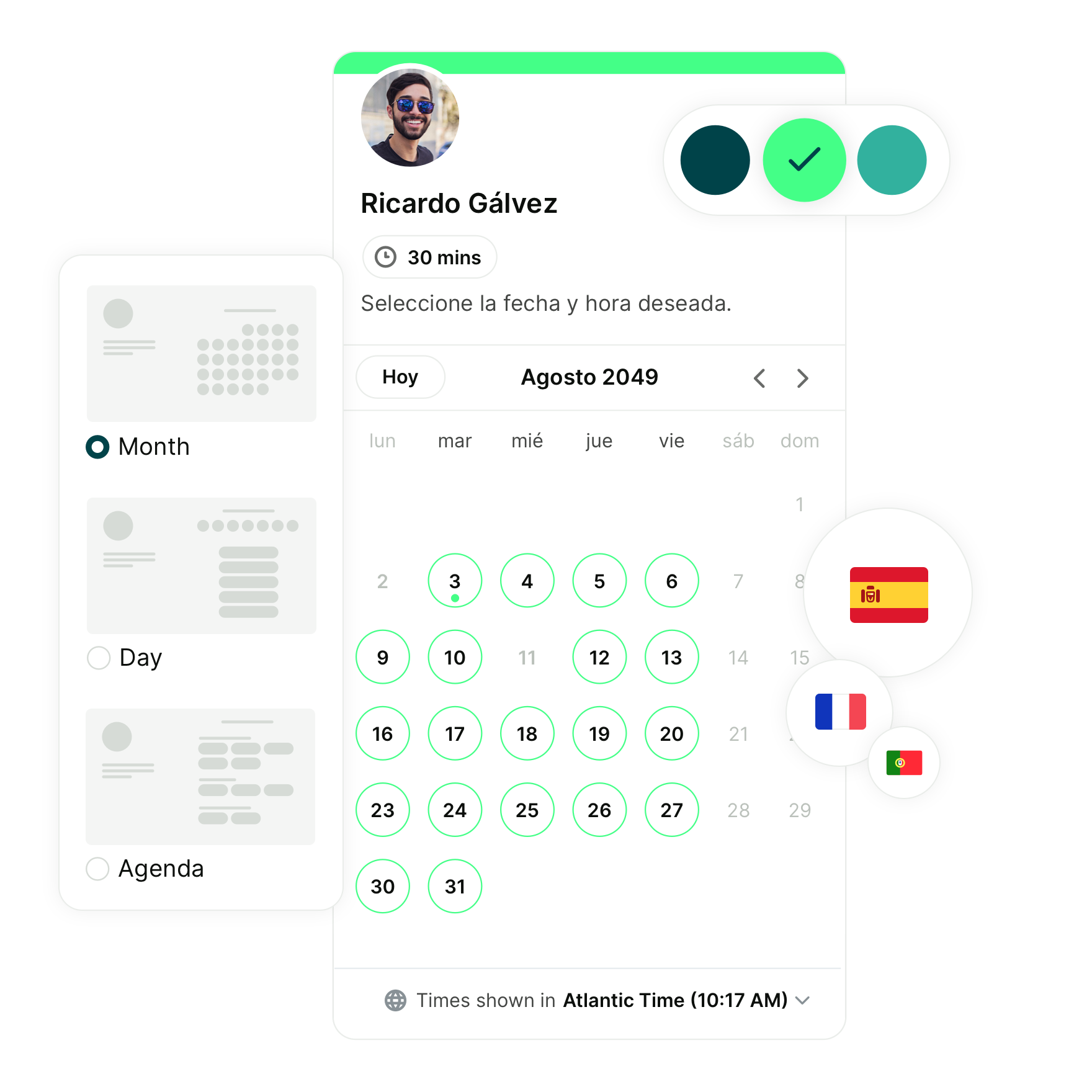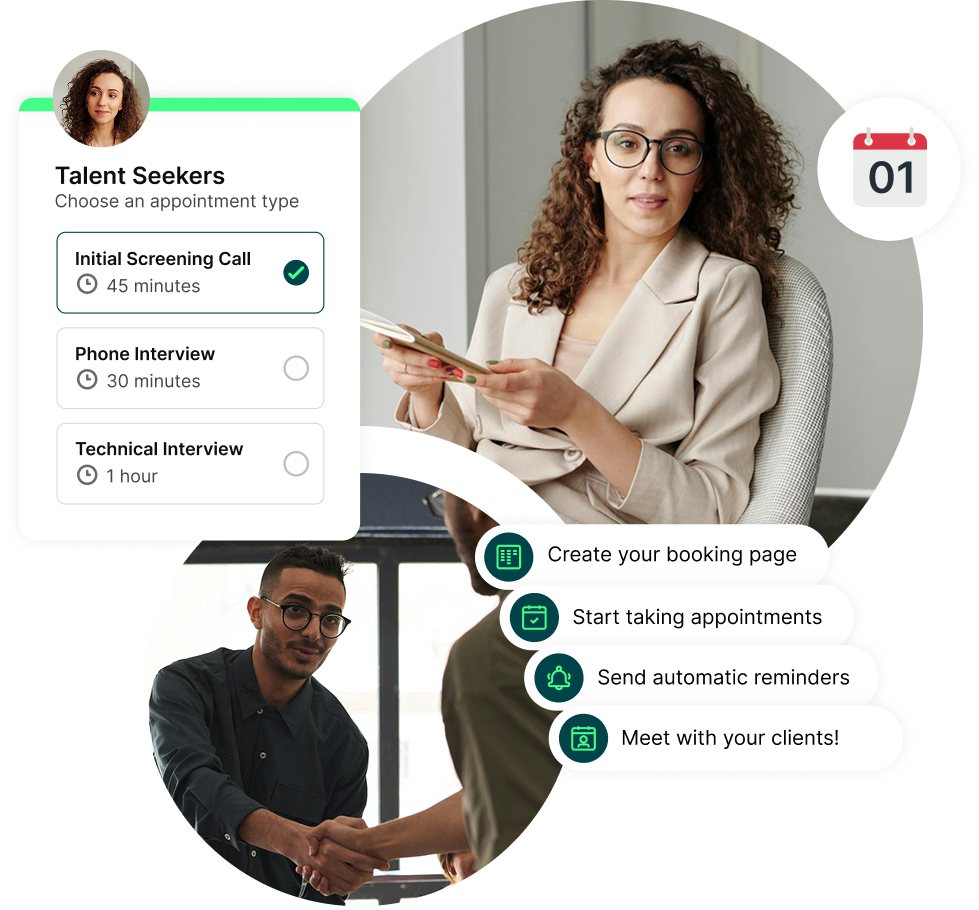6 Candidate Rejection Email Templates You Can Personalize
What’s the first step to planning a killer meeting? The meeting invitation email, of course! See how to maximize every invite to ensure engaging and on-topic discussions.

Paulina Major

Ready to book more meetings?

Hiring is exciting. It means your team is growing and you’re about to welcome fresh skills, perspectives, and ideas.
But there’s also a harder side to the process: You can’t hire everyone. At some point, you’ll need to send a candidate rejection email, and how you write it matters. A thoughtful message can leave the candidate with a positive impression and may even encourage them to apply again in the future.
In this article, you’ll learn:
- Why you should send a rejection email
- Best practices for writing them
- Six ready-to-use candidate rejection email templates for different stages of the hiring process
Do I need to send a rejection email?
Yes. Sending a candidate rejection email is one of the simplest ways to show respect for someone’s time and effort. It signals that you value every applicant, even if they are not the right fit for the role. But there’s more to it. ⤵️
It’s the right thing to do
Candidates invest energy in tailoring their resumes, preparing for interviews, showing up, and really trying to impress you. It wouldn’t be fair to leave them in limbo if you don’t pick them. It’s important to close the loop and be human!
|
💡Pro tip: Hiring the right candidate starts with a smooth interview process. Before you get to the rejection stage, make sure your hiring process sets candidates up for a great experience from the start. Check out our step-by-step guide on how to schedule interviews, packed with best practices and ready-to-use interview invitation templates. |
It protects and strengthens your employer brand
Something you need to remember is that your hiring process is a direct reflection of your company’s values. Every touchpoint, from the job posting to the final decision, shapes how candidates talk about you. A respectful rejection communicates that you value people’s time and effort, even when the outcome isn’t in their favor.
The long-term payoff is significant, too. Companies known for treating candidates poorly risk damaging their reputation in the job market, which can make attracting top talent harder. On the other hand, organizations that handle rejections with professionalism and empathy build stronger employer brands and a more positive talent pipeline.
In a LinkedIn poll, 69% of respondents said they would reapply to a company that once rejected them. Only 8% said they would not. The remaining 23% said “it depends,” showing that your approach can directly influence whether great candidates give you another chance.
It keeps future hiring options open
A “silver medal” candidate in this hiring cycle could be your perfect hire in the next one. Talent pools shift, skill sets evolve, and role requirements change. You should always maintain a positive relationship throughout your hiring process. But, a thoughtful rejection helps you keep those candidates warm for future requisitions without starting from scratch.
How to write a professional and empathetic candidate rejection email
Okay, so how do you actually write a professional candidate rejection email? What are the most important things to keep in mind? And how do you make sure you’re balancing professionalism with empathy so candidates leave with a positive impression, even if they didn’t get the job?
Let’s walk through the core principles together.
Express gratitude for their time and effort
The best place to start is with a genuine thank you. Candidates commit significant time and energy to applying, interviewing, and sometimes completing assessments. Opening with appreciation immediately sets a respectful tone and helps humanize your message. A simple line like “We truly appreciate the time you spent speaking with our team and preparing for the process” goes a long way.
Do what you can to personalize the message
The next important step is to personalize your email as much as possible. A rejection should never feel like it was written by a robot.
In high-volume hiring, personalization might be as simple as addressing each candidate by name and referencing the role they applied for. For smaller pools or candidates who progressed further, you can go deeper. For example, you can acknowledge something specific from their interview or a skill that stood out.
Be clear and concise
Now, when it comes to delivering the actual message, try to avoid vague wording that could cause confusion or false hope. Let the candidate know clearly that you’re not moving forward while keeping the language warm and respectful.
For instance: “After careful consideration, we’ve decided to move forward with another candidate whose experience more closely matches the role requirements.”
Once you’ve made the decision clear, you have the opportunity to add empathy and encouragement to help soften the impact.
Lead with empathy and encouragement
Rejection is rarely welcome, but the way you phrase it can make all the difference. Acknowledge the candidate’s strengths or highlight something they did well. If it’s genuine, encourage them to apply again in the future or to stay in touch.
When you show empathy, it opens the door to continued dialogue, which brings us to the next point.
Keep communication channels open
If it feels appropriate, invite the candidate to connect on LinkedIn, join your talent community, or keep in touch for future opportunities. But only offer this if you genuinely mean it. Following up later with a “silver medal” candidate can save you valuable sourcing time in future hiring rounds.
Avoid same-day rejections after interviews
Rejecting someone on the same day as their interview can feel rushed and transactional. Even if you’re confident in your decision, taking 24–48 hours allows for thoughtful review and shows that you gave the application proper consideration. LinkedIn research suggests sending a rejection within two business days to balance respect with timeliness.
Offer constructive feedback when possible
The same study by LinkedIn revealed that 94% of candidates want feedback after an interview. If you can give it, make sure it’s specific, actionable, and relevant. You might highlight a strength they demonstrated, followed by an area for improvement. Avoid vague comments like “We went with someone more qualified,” as they don’t help anyone. For top candidates, consider a short follow-up call to provide more detailed insights.
|
💡 Pro tip: Part of a successful interview process is having the right tools to schedule your interviews. Many recruiters use scheduling tools to hire top talent. Check out our guide on free interview schedulers for the different solutions on the market. |
Right, let’s now dive into the templates.
Candidate rejection emails for every stage of the hiring process
If you have a multi-step hiring process, narrowing down candidates as you go, you’ll need not one, not two, but several email templates on hand.
Here are six candidate rejection email templates you can copy, customize, and send whenever you need them.
Rejection at resume stage (pre-screening)
This template is for applicants who don’t meet your basic criteria and won’t be moving forward to an interview. Keep it polite, brief, and neutral. There’s no need for detailed feedback at this early stage.
Subject: Your application for [job title] at [company name]
Hi [first name],
Thank you for your interest in the [job title] position at [company name]. We appreciate you taking the time to apply and share your background with us.
After reviewing your application, we have decided to move forward with other candidates whose qualifications more closely match the role’s requirements.
We encourage you to check our careers page for future openings that match your skills and experience.
Wishing you all the best in your job search,
[your name]
[your job title]
[company name]
Rejection after a screening call
If you’ve had a screening call and decide not to move forward with a candidate, use this email template to let them know you won’t be proceeding with their application. Keep it polite, acknowledge the conversation, and thank them for their time.
Subject: Update on your application for [job title]
Dear [first name],
Thank you for taking the time to speak with me about the [job title] role at [company name]. It was great to learn more about your background, skills, and career goals.
After careful consideration, we have decided to move forward with other candidates because [brief reason, e.g., “we are looking for more direct experience in X” or “another candidate’s skills more closely matched the role’s requirements”].
We appreciate the time you took to connect with us and encourage you to apply for future opportunities at [company name].
Wishing you the best in your job search,
[Your signature]
Rejection after early-stage interview
If a candidate has completed an initial interview with you or a team member but won’t be moving forward, the rejection should be polite and a bit more personalized.
As Hiba Amin explains, “If you spent time talking to a candidate who isn’t moving forward, don’t use a boilerplate rejection letter. The least you can do is share your reasoning.” Providing personalized, constructive feedback not only gives them closure but also shows that you value the effort they put in.
Subject: Follow-up on your interview for [job title]
Hi [first name],
I wanted to follow up on your recent interview for the [job title] position. It was a pleasure to learn more about your work in [specific area] and your approach to [related skill].
After comparing all candidates, we’ve chosen to move forward with those whose experience more closely matches the role’s short-term objectives. For this position, that meant [expanded reason, e.g., “more direct experience in scaling marketing operations in international markets”].
This was a competitive round, and your professionalism and insight stood out. I hope you’ll consider applying for future opportunities with us, as I believe your background could be a strong match for other roles.
Kind regards,
[your name]
Rejection after the assignment stage
If a candidate has completed a task, case study, or skills assessment, they’ve invested more time than in earlier stages. Your rejection should reflect that effort, acknowledge their work, and, if possible, provide constructive feedback.
Subject: Thank you for completing the [assignment/project name]
Dear [candidate’s first name],
I want to sincerely thank you for the time and effort you put into the [assignment/project] for our [job title] role. We were impressed by the thought and creativity you brought to your work.
After reviewing all submissions, we’ve decided to move forward with candidates whose deliverables more closely matched what we need for the role right now. In particular, we were looking for [expanded reason, e.g., “more depth in data visualization and storytelling”].
We truly appreciate the energy and care you put into your work, and we hope you’ll consider applying again for future roles with [company name].
All the best,
[your signature]
Rejection with specific feedback
Sometimes it’s appropriate (and appreciated) to give a candidate clear, constructive feedback about why they weren’t selected. This can be especially valuable for candidates who made it to later stages or were strong contenders. When giving feedback, be specific, actionable, and tactful.
Subject: Your application for [job title] – feedback enclosed
Hi [first name],
Thank you for your interest in the [job title] position and for the time you invested throughout our process. I truly enjoyed our conversations and hearing about your work in [specific project or area], as well as your approach to [skill or task].
After reviewing all finalists, we have decided to move forward with another candidate whose recent experience more closely matches our current priorities. For this role, we were prioritizing [specific feedback, for example, “hands-on experience leading enterprise-level product launches in international markets”]. This was a difficult decision because you brought valuable strengths to the table, particularly [positive note, for example “your ability to clearly explain complex technical concepts”].
I hope you will stay connected by keeping an eye on our careers page or reaching out directly, as I believe your background could be a strong match for future opportunities here.
Wishing you all the best in your next steps,
[your signature]
Rejection after final interview round
When a candidate has made it to the final stage, they have invested significant time, effort, and emotional energy. Your rejection here should be as personal and considerate as possible, making sure they understand the decision was carefully made and that their efforts were valued.
Subject: Follow-up on your [job title] interview
Dear [first name],
Thank you for the time, preparation, and thought you put into the [job title] interviews. It was a pleasure to get to know you and to learn more about your skills, experience, and professional goals.
After much discussion, we have decided to move forward with another candidate whose experience is more closely aligned with the immediate priorities of this role. In particular, we were seeking [specific feedback, for example, “extensive experience leading cross-departmental product launches”].
This decision was not easy, and it reflects the high calibre of candidates we met at this stage. I hope you will consider applying for future roles with [company name], as we believe your expertise could be a strong fit in the future.
Wishing you every success in your career,
[your signature]
Wrapping up
Sending a thoughtful candidate rejection email is not just polite, it is good business. Every interaction shapes your reputation and can influence whether great talent applies again.
Use the templates above to save time while still personalizing your message. When possible, offer constructive feedback and keep the door open for future opportunities. Treat each candidate as you would want to be treated if the roles were reversed.
If you also want to save time on the other end of the process, streamline your interview scheduling with YouCanBookMe. Our all-in-one interview scheduling tool lets candidates book interviews instantly based on your team’s real-time availability, without the back-and-forth emails. You can set up one-on-one, panel, or virtual interviews, send automated reminders to reduce no-shows, and personalize booking pages to reflect your employer brand. The result is a faster, smoother hiring process for both you and your candidates.
Create your free booking page today!
FAQ
How do you politely reject an internal candidate?
Acknowledge their contributions and value to the company. Thank them for applying and explain the decision clearly, focusing on role-specific requirements rather than personal shortcomings. When possible, you should also offer constructive feedback, outline growth opportunities, and discuss potential career paths within your organization.
How can I make a rejection email feel more personal?
As a bare minimum, you should address the candidate by name and reference something specific from their application or interview. Highlight a strength you appreciated, even if they were not selected. Personal touches show you paid attention and help the candidate leave with a positive impression.
How long should a candidate rejection email be?
The length of a candidate rejection email should reflect how far the person made it in your hiring process and the nature of the role. If you are rejecting someone at the application or resume review stage, 4–6 sentences are often enough to thank them, share the outcome, and wish them well. If the candidate progressed to later stages, such as interviews, skills tests, or final rounds, your message should be longer, typically 150–250 words. This gives you room to personalize your response, provide constructive feedback, and acknowledge the time and effort they invested.
Subscribe to our newsletter
Get productivity tips, news, articles and resources.
Written by
Paulina Major
Paulina grew up wanting to be a commercial pilot, but life steered her toward content writing. With a passion for tech and business, she’s found her calling in helping brands share their stories every day. Her non-negotiable? Morning coffee—because nothing starts without that first sip.




